The top 10 fighter aircraft of 2019 (BVR combat)

By September 2019, three fighters types were equipped with the new generation MBDA Meteor missile. A Meteor-armed Typhoon intercepting a Russian Flanker close to Estonian air space in 2019.
The ‘AMRAAM Age’ is over, once the weapon that separated the ‘haves’ from the ‘have-nots’, the ‘Slammer’ is now outmatched by a new breed of long range air-to-air missiles. The PL-15 in China and the Meteor in Europe have usurped the American weapon’s supremacy, a position only likely to be reversed when the AIM-260 enters service. Has a year passed already since our last BVR top 10? Yes indeed it has, and the latest news, that French Rafales are now carrying the Meteor long-range missile has had a radical effect on our ranking. Meanwhile in China, Flankers and J-10Cs are now flying with the PL-15, but it is believed they are not at a level of maturity that will upset the applecart, for this year anyway. In Russia, development work continues on the R-77M with its AESA seekerhead offering a larger field of regard than existing technology.
To excel in beyond visual range (BVR) air combat a fighter must be well-armed and equipped with capable avionics. It must be able to fly high and fast to impart the maximum range to its missiles, allowing them to hit the enemy before he is even aware of their presence. The aircraft must give its crews sufficient situational awareness not to shoot their friends down, and be easy to operate so it can deploy its weapons quickly and accurately. The black magic of the aircraft’s electronic warfare suite can also come into its own, reducing the opponent’s situational awareness. Situational awareness, weapons capability and combat persistence are probably more important than manoeuvre capability (g), although transonic and supersonic acceleration are helpful in creating opportunities to survive & win multiple engagements.
Hardware is generally less important than training and tactics — removing these human factors from the mix allows us to judge the most deadly long-range fighting machines currently in service. The exact ordering of this list is open to question, but all the types mentioned are extraordinarily potent killers. This list only includes currently active fighters (so no Su-57s etc) and only includes weapons and sensors that are actually in service today.
The process we used to arrive at our conclusion can be seen here.
(Contenders for the number 12 slot included the J-10, FC-1, Iranian F-14, MiG-35, Mirage 2000 and F-2)
11. Lockheed Martin F-16E

OK, so we said ‘top 10’, but the F-16 deserves a mention. A great sensor suite, including a modern AESA (the APG-80) and comprehensive defensive aids systems is combined with advanced weapons and a proven platform; a small radar cross section also helps. However, the type is let down by mediocre ‘high and fast’ performance, and fewer missiles and a smaller detection range than some of its larger rivals. Older F-16s, including some USAF examples are being upgraded with the APG-83 AESA radar. Israeli F-16s also deserve an honourable mention for their advanced jamming and avionics systems, but are largely tasked with ground attack. The next advanced variant of the Viper, the F-16V/Block 70, has been ordered by Slovakia and Bahrain.
The ‘F-21’ (a designation some may say intended to avoid the Pakistani associations the F-16 has to many in the Indian Air Force) offered to India would have a widescreen cockpit and impressively modern systems.
Armament for A2A mission: 4 x AIM-120C-7 (Ds in some cases), 2 x AIM-9X (1 x 20-mm cannon).
10. Boeing F/A-18E/F Super Hornet
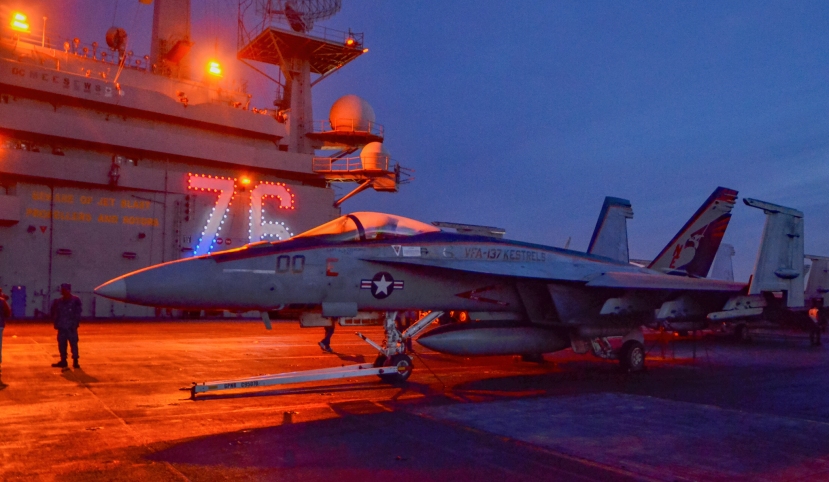
The Super Hornet is akin to a luxury sports car without a big enough engine: it has all the ‘bells and whistles’ (a very powerful advanced radar, reduced radar cross section, an excellent cockpit, data-linking capability and good weapons) but lacks the grunt to make the most of its superb systems at higher speed and altitudes. The weapons carriage is also among the draggiest configuration. If the US Navy receives the new generation BVR missile it wants, it is likely that the Super Hornet will be the first to receive.
Though in an actual BVR engagement pilot training levels and the aircraft’s place in a larger system are decisive, we are looking at the aircraft as a weapon system in a like-for-like way — so many of the US Navy’s Super Hornet’s advantages are removed. A planned Block III upgrade will see the addition of conformal fuel tanks to increase reach, further reduced radar conspicuity and the addition of a modern wide display cockpit.
Read an exclusive interview with a Super Hornet pilot here.
This list, which for the sake of brevity (largely) treats aircraft as isolated weapon systems, does not favour the Super Hornet: in reality, with support from E-2Ds and advanced other assets, US Navy Super Hornets would be extremely capable in the BVR arena against most adversaries.
Armament for A2A mission: Super Hornet (high drag ‘Christmas tree’) 12 x AIM-120, realistic = 6 x AIM-120C-7/D+ 2/4 AIM-9X ) (1 x 20-mm cannon)
9. Sukhoi Su-35

The Su-35 is considerably more capable than earlier ‘Flanker’s and would pose a significant challenge to any ‘eurocanard’. Su-35S were deployed in Syria in 2016 to provide air cover for Russian forces engaged in anti-rebel/ISIL attacks. The Su-35 is even more powerful than the Su-30M series and boasts improved avionics and man-machine interface. More on the Su-35 can be found here. Many of the teething problems encountered in Syria have now rectified. One ace the Su-35 has in its sleeve is the inclusion of the R-27T medium range infra-red guided missile (seen on aircraft deployed to Syria) – which is potentially effective against low radar cross section aircraft and has no American equivalent. One Russian analyst we spoke to questioned the effectiveness of the R-77 noting Russia’s lack of investment in modernising the weapon and the glacial pace of development of ultra-long range weapons for the Su-35.
The Su-35’s supremacy as the most potent Flanker variant may be challenged by the Chinese J-11D is some areas, notably the latter’s AESA radar, but its is believed that the J-11D is not yet in full mature operational service. Also some observers, notably in the US Navy, rate the latest Chinese air-to-air missiles as superior to their Russian counterparts.
The Su-35 represents the Flanker series for this list but other high-end T-10 series aircraft include the Su-30, J-11B and J-16. (See Idiot’s guide to Flankers here.)
A2A armament: 6 x R-77 or R-27T, 4 x R-73 (1 x 30-mm cannon)
Location of target
In terms of radars, the Su-35S’s Irbis-E PESA radar provides extremely high power levels allowing target detection beyond 300km (although without weapons which can engage at this range), as well as claimed advances in detecting low-observable threats such as stealth fighters at significantly beyond visual range. However, the downside to this is that the Irbis-E has to operate at extremely high power levels to achieve this performance and so is easily detectable and track-able at ranges beyond those at which it can track. All radars except AESAs with very low probabilities of intercept such as the F-22’s APG-77 suffer from this paradox but it is worse for the Su-35 because of the latter’s very large RCS and IR signature which means it must rely on out-ranging its opponents at BVR rather than trying to sneak up on them whilst relying on passive tracking.
Engage and defeat the target
Su-35 benefits from superb Russian missile design expertise. The multiple seeker-head mix which Russian fighters would fire in missile salvos in combat makes defending against them a very complicated task. At long range, the Su-35 can fire a mix of semi-active radar homing, anti-radiation (home on jam) and IR homing missiles, whilst at short range the ‘Archer’ series remains as deadly as ever. Typhoon has the excellent ASRAAM and IRIS-T short range IR missiles which can equal or surpass their Russian counterparts, but at long range the AMRAAM is showing its age and against Digital Radio Frequency Memory (DRFM) jamming technology which the Su-35S employs, its Pk drops significantly to the point that multiple missiles would likely be required to kill each target.
BVR engagements are all about situational awareness, positioning/energy advantage, and persistence in terms of fuel and missiles. In all but the latter category the Su-35 is hopelessly outclassed by the F-22 (as are all other operational fighter aircraft). Even in terms of missiles, the Su-35 can carry up to twelve to the F-22’s eight but combat practice, especially against stealthy targets, involves firing salvos of six missiles with mixed seekers so the Su-35 only really has two credible shots
Disengage at will
Repeat as necessary
Abundant fuel reserves and a large weapon load.
8. Mikoyan MiG-31BSM ‘Foxhound’
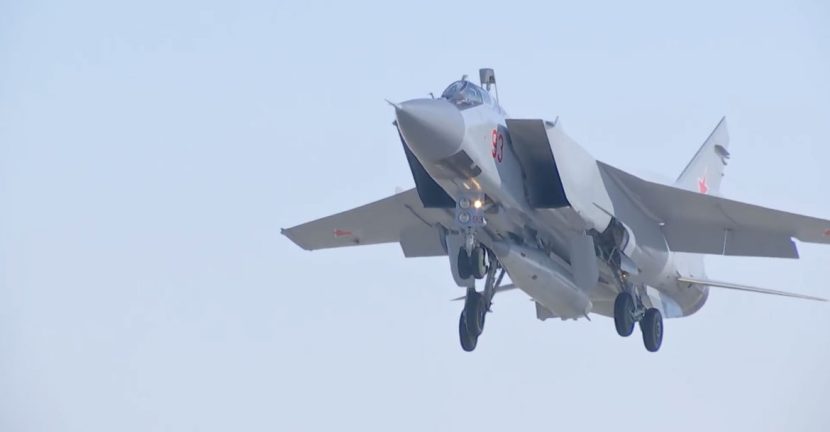

As a defender against bombers the MiG-31 may well be the most potent interceptor in the world. In our article that explained the judging criteria for this top 10, analyst Jim Smith noted ” (The) Air Defence of Russia drives you towards the MiG-31. You have to have a big, fast, aircraft because you can’t avoid the possibility of having to cover a fair distance at high speed to meet the threat. Being big means a big sensor and long-range weapons are available, and both are likely to be needed. You may be less concerned about signature and platform manoeuvrability because your ideal approach will be to stand back and hit bombers rather than engage fighters.”
Interview with a MiG-25 pilot here.
The MiG-31 is designed for maximum BVR performance. Against bombers and cruise missiles it is superbly capable (and would be ranked higher on this list), however as a defensive interceptor it is vulnerable to more agile and stealthier fighter opponents. The fastest modern fighter in the world, with a top speed of Mach 2.83+, the MiG-31 offers some unique capabilities. Until the advent of Meteor-armed Gripens and Typhoons, no operational aircraft had a longer air-to-air weapon than the type’s huge R-33, which can engage targets well over 100 miles away (it may well out-range the AIM-120D). The recent R-37M, which is believed to be in limited operational service (though there is no open source material to support this claim) is even more potent and may even have some advantages over Meteor.
Designed to hunt in packs of four or more aircraft the type can sweep vast swathes of airspace, sharing vital targeting information by data-link with other aircraft. The enormous PESA radar was the first ever fitted to a fighter. The type is marred by a mountainous radar cross section and abysmal agility at lower speeds. More on the MiG-31 here and here.
Thank you for reading Hush-Kit. This site will pause operations in December if it fails to reach the required funding levels. If you wish to help, please donate here.
7. Chengdu J-20

China is the second nation in the world to put an indigenous stealth fighter into operational service. With a hypothetical really long-range anti-air weapon, this relatively stealthy platform could force essential support assets such as tankers and AEW platforms to stand back, reducing situational awareness and combat persistence for opposition aircraft. Perhaps the J-20 should be thought of as a stealthy MiG-31, aimed at large area airspace denial rather than an air superiority fighter per se, though the J-20 is generally described as an F-22 Raptor-class aircraft. In many ways this is true, but the J-20 is particularly interesting because of its rather different configuration. The J-20 has a canard-delta rather than the (essentially) tailed-delta of both the Raptor and the Su-57 (which has yet to enter service). Additionally, unlike Typhoon, the canard is not closely coupled to the wing. The main benefit to be gained from this arrangement is the carriage of significantly more fuel, coupled with the scope for use of a longer weapons bay. The additional fuel could confer either additional range, or long combat persistence, and this suggests that, if armed with a long-range AAM a role as an anti-AWACS or anti-tanker system. The large weapons bay might also provide sufficient volume for a wide range of weapons. What of the compromises? I would suggest less energy manoeuvrability, as the configuration is likely to have somewhat higher transonic drag. In addition, signature (other than head-on) looks likely to be a bit greater. Head on signature could be comparable to competing systems if appropriate engine installation and airframe treatments are used. The canard, is likely, to be at low deflection for supersonic flight, especially if Su-35-like thrust vectoring is available to trim the aircraft. It is not clear from open source literature if this is the case, but it is likely the PLA are looking into it. It is only the type’s immaturity that keeps it from a higher placing, and it is likely to move up this list next year.
Stealth, supercruise and the modern weapons mean the J-20 is likely to mature into an extremely capable, and unique, aircraft. Achieving this depends on the degree to which China can overcome its historical problems with engine developments.
It is likely that the J-20 is less stealthy than the F-22 and F-35, and at least one member of the F-35 community has stated that he does not believe the J-20 is a low observable in meaningful sense. The perennial issue of immature Chinese engine technology is yet to be solved, and the current status of the Xian WS-15, the powerful definitive service engine, is unclear. The current interim WS-10, and in particular the WS-10G engine, is powerful, but the WS-15 is (or will be) able to make the most of the airframe in terms of acceleration and supercruise.
Location of target
The J-20 carries a modern AESA in a nose large enough to accommodate a set of 2000-2200 transmit/receive modules. Detection abilities are likely to be excellent.
Engage and defeat the target
Assessing the J-20s capability in this sense is hard. Giving the J-20 a very long range weapon would be a logical step and it is believed that this weapon is currently in testing. In 2016 China downed a target drone with a massive air-to-air missile. This could be a very long range air to air missile (VLRAAM) with ranges exceeding 300 km. Far greater than any Western weapon. The long-range PL-15 is mature enough to be worrying the US and is a catalyst for the development of the US AIM-260 which is rumoured to be further down the development path that publicly quoted.
Disengage at will
Supercruise and a degree of stealth (though probably less than the F-22 from most aspects) will give the J-20 options, though it is likely to lack the energy manoeuvrability of the F-22.
Repeat as necessary
Massive fuel reserves (if combined with an efficient engine) and a large weapons bay are likely to make the J-20 one of the best aircraft in this regard.
Armament: 6-8 x new generation PL-12C/PL-15s or new generation BVR missile+ 2 x PL-10
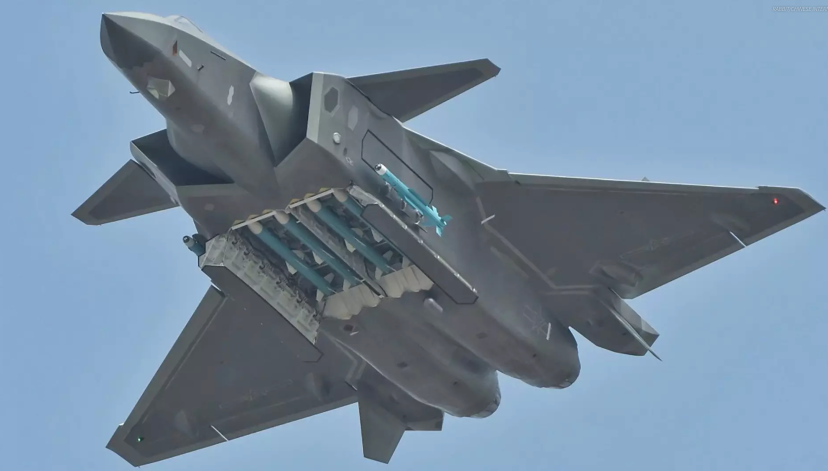
6. McDonnell Douglas F-15C (V) 3/Boeing F-15SG/F-15SE Eagle

US F-15Cs were among the first fighters in the world to receive the AIM-120D AMRAAM, the best Western air-to-air missile after the Meteor.With an estimated 100mile range, new hardware and software systems for improved navigation, an improved HOBS (High-Angle Off-Boresight) capability, the D model offers a significant advantage. Though far from fleet wide, USAF has a number of F-15Cs fitted with both theAPG-63(V)3 radar and the AIM-120D, these Golden Eagles boast a superior radar to any non-US types. With a massive effective radar, good range, combat persistence and a high level of maturity, the Eagle remains extremely potent. Plans to equip it in the future with a new generation US BVR missile could push all the American aircraft in this chart up in our rankings.
Though the famously one-sided score sheet of the F-15 should be taken with a pinch of salt (Israeli air-to-air claims are often questionable to say the least), the F-15 has proved itself a tough, kickass fighter that can be depended on. It lacks the agility (certainly at lower speeds) of its Russian counterparts, but in its most advanced variants has an enormously capable radar in the APG-63(V)3. The F-15 remains the fastest Western fighter to have ever entered service, and is currently the fastest non-Russian frontline aircraft of any kind in the world (though an F-15 pilot we spoke to here said he’d never got a clean eagle over Mach 2.3). The type is cursed by a giant radar cross section, a massive infra-red signature and an inferior high altitude performance to a newer generation of fighters.

Though Saudi F-15SAs are extremely advanced they are not considered mature and rumours hint at problems with the aircraft. The latest F-15s will benefit from the greatest amount of computing power of any aircraft. The F-15X is a suggested variant with the latest technology and ‘missile truck’ mass AMRAAM load-outs (able to act as the ‘muscle’ to the Raptor’s ‘eyes’ in mixed formations). USAF is likely to receive a batch of these new generation Eagles, showing both its faith in the type and demonstrating the current belief that stealth-only air forces are too exquisite and lacking in ‘air mass’ (or ‘wings in the air’ – the aerial equivalent of ‘boots on the ground’). The next Eagles for USAF will be extremely well-equipped, superior even to the F-35 and F-22 in some defensive aids and sensor areas.
A2A armament: 6 x AIM-120C-7 or AIM-120D 2 x AIM-9X

5. Saab Gripen
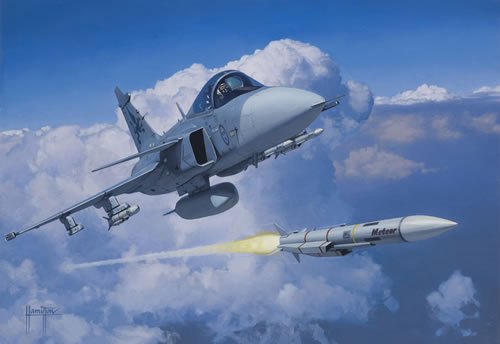
Some caution could be expressed about the Meteor, as it is far from being a combat proven weapon. But the signs are encouraging, with the order-book stacking up and a large amount of time, money and effort put into the weapon’s development. In our original list from five years ago, the Gripen did not even make the top ten. Its dramatic jump to the number two position in 2016’s list here was due to one reason: the entry into operational service of the MBDA Meteor missile. The Gripen was the first fighter in the world to carry the long-delayed Meteor. The Meteor probably outranges every Western weapon, and thanks to its ramjet propulsion (an innovation for air-to-air missiles) it has a great deal of energy, even at the outer extremes of its flight profile, allowing it to chase manoeuvring targets at extreme ranges. Many air forces have trained for years in tactics to counter AMRAAM, but few know much about how to respond to the vast No Escape Zone of Meteor. This combined with a two-way datalink (allowing assets other than the firer to communicate with the missile), the aircraft’s low radar signature, and the Gripen’s pilot’s superb situational awareness makes the small Swedish fighter a particularly nasty threat to potential enemies. The Gripen is not the fastest nor longest-legged fighter, nor is its radar particularly powerful. It would have to be used carefully, taking advantage of its advanced connectivity and superior Electronic Warfare systems to make the most of its formidable armament.
Let’s suppose you have a small-ish nation, where the Government does not have global dominance in its agenda. For such a nation, the key aim is deterrence, ensuring that any country wishing to invade or dominate you cannot easily do so. For such a nation, Gripen/Meteor might be the ultimate air defender, especially if you have a well-integrated air defence system and dispersed bases. Never being far from the border or a base, fuel volume and even weapons load don’t matter so much, because you’ll scoot back to your cave and re-arm/refuel. Having a big stick, however, is great, because you can defeat threats while keeping out of their missile range.
4 x MBDA Meteor + 2 x IRIS-T (1 x 27-mm cannon)
4. Lockheed Martin F-35A/B Lightning II
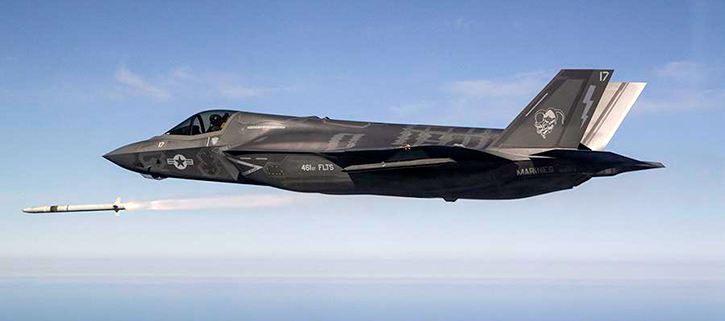
The F-35 is perhaps the hardest aircraft to place on this list as its stealth and situational awareness should give it a very high ranking but reports continue to circulate regarding problems with the aircraft’s AMRAAM integration. It is (largely) this lack of a mature AMRAAM capability that stop it taking the number two slot that one might expect given of such a sophisticated system. Its appalling reliability and extremely high-maintenance demands (many shared with the F-22) also count against it. In 2017 the F-35 had a mission capable rate of 54.67%, which is terrible, by 2018 this had dropped by a further 5.1 points to 49.6% percent. To put this into perspective the famously prissy B-1B which is very big, very complicated, old, has swing wings and four engines may now have a superior mission capable rate. It appears that with a ‘fifth generation’ aircraft you get a mission capable rate of around 50% compared to 70% for a thirty year-old fourth generation aircraft (it is likely that the Eurocanards offer even better rates if assessed in the same way). How ever good a fighter is in theory, it has to be ready to fight to be able to fight.
In Location of target the F-35 scores very highly, being arguably the best fighter in terms of sensors and data connectivity. Stealth and unparalleled situational awareness make a potent beyond visual fighter of the F-35A, despite its pedestrian kinematic performance. The F-35A has gained a formidable reputation in large-scale war-games; against conventional opponents the F-35 raking up a reported 17-1 simulated aerial victories. The F-35, if it is to stay in a stealthy configuration, has fewer missiles than its rivals. It also lacks the agility and high altitude performance of the F-22, Rafale or Typhoon. A word of caution about the high ranking we have given the F-35: procurement moves by the US (both F-22s and 6th Gen’ plans), Japan (with the F-3) and Turkey (prior to the 2019 F-35 boycott) with the TF-X show that those who can afford an alternative don’t consider the F-35 a viable air superiority platform. This flies in the face of public announcements by Lockheed Martin, USAF and F-35 pilots regarding the aircraft’s effectiveness in the role, but it is hard to read the facts in any other way.
Smaller BVR missiles now being studied may address the shortcoming in combat persistence which prevents the type from taking full advantage of its stealth and SA advantage.
4 x AIM-120C-5 + 2 AIM-9X (1 x 25-mm cannon)
3. Eurofighter Typhoon FGR.4
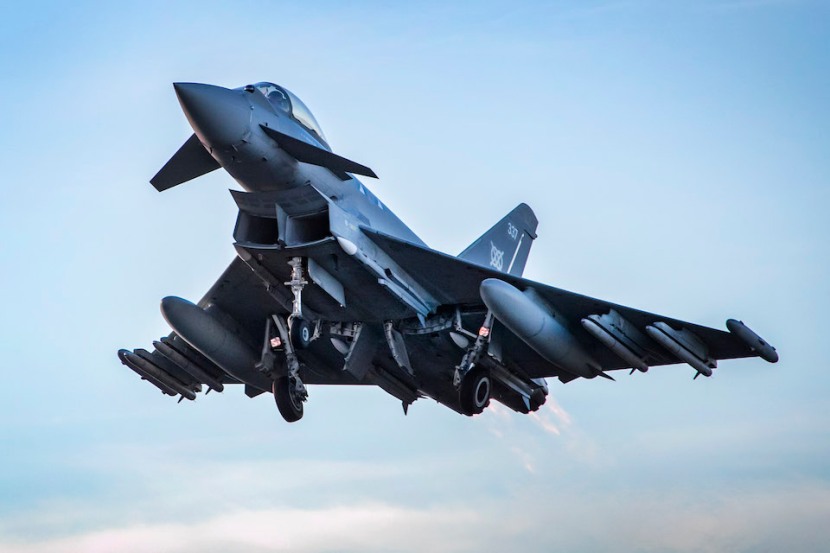
Typhoon is still the best armed fighter in the world for beyond visual range combat, bar none. The Typhoon is very fast, high flying and energetic, imbuing its AMRAAMs and Meteor with a longer reach than those launched by lower performance aircraft. RAF Tranche 1 Typhoons are not Meteor compatible but will instead be fitted with AIM-120D in a deal that was signed in July 2018. Saudi Arabia began operations with Meteor-armed Typhoons in late 2019.
Its greatest weakness remains its lack of an AESA radar and its non-stealthiness. Against a stealthy opponent, for example the J-20 (when fully mature), the Typhoon will be at a large disadvantage and without the support of off-board sensors (from friendly F-35s for example) will struggle to get first-look and first-kill. The Typhoon is one only two aircraft on this list (the other is Gripen) with a mechanically scanned radar, a 20th century technology which leaves the sensor “… on the verge of complete obsolescence, with an inherently greater vulnerability to jamming and an inability to fully exploit the performance and capabilities of new weapons” according to some in the RAF Typhoon community. However, the radar is a decent size, with good detection range and is fully mature. Future Typhoons will carry the Captor E ‘Radar Plus One’, a new pivoted wide-view AESA, with the chance of an all new Radar Plus Two further in the future. Upgrades now planned will improve the EW suite, engines and cockpit. Though excellent for its day, the cockpit is a generation behind the large screen F-35 and nascent Gripen E.
Interview with a Typhoon pilot here and here
A2A armament: Up to six Meteor/AMRAAM AIM-120C5 + 2 or 4 AIM-132 ASRAAM/IRIS-T
2. Dassault Rafale C

The Rafale F3R upgrade standard — introducing Meteor capability— was qualified in late 2018 , but it was not until September 2019 that the new missile was seen on squadron aircraft. Though initial operational capability is yet to be officially declared, it is likely that it the capability is either already in place or extremely close. This puts Rafale ahead of Typhoon for the first time since our BVR top 10 began in 2013. Typhoon still enjoys a thrust-to-weight advantage (giving its Meteors potentially greater range and energy) and two (rather than one-) way data-link with its the new weapon, but these may be mitigated by the Rafale’s more sophisticated radar and defensive aids.

Qatari Rafales may already be training with helmet mounted displays.
F3R involves major software upgrades, and the full integration of Thales TALIOS long-range airborne targeting pod. Though primarily an air-to-ground sensor the pod will improve target detection and identification.
Other than real stealth, the only disadvantage suffered by the type, which has a good performance, an excellent defensive aids suite and a high level of sensor fusion, was the absence of a helmet-mounted display. This has now been rectified (it is believed that Qatari Rafale are operating with HMD). Rafale has a more advanced radar than the other European and Russian fighters and weapons (Mica and the Meteor) that the Russians and Chinese do not known as well as the elderly and universal AMRAAM, and thus may be less able to counter. Though it should be noted that Meteor has not been tested in combat. The addition of HMD and Meteor has made the already excellent Rafale even more potent, and a strong contender for the best multi-role fighter in the world.
A2A armament: 2 x Meteor + 4 x MICA (normal service load-out) (or – rarer- four Meteor and two Meteor)

A Meteor on an a Rafale of the 4e Escadre de Chasse at Saint-Dizier. Official IOC confirmation has yet to be announced but it is likely to be very soon.
1. Lockheed Martin F-22 Raptor

Undisputed king of beyond-visual range air combat remains the F-22 Raptor. Its superbly stealthy design means it is likely to remain undetected to enemy fighters, calmly despatching its hapless opponents. The only potential rivals, the Russian Su-57 and Chinese J-20, remain immature.
The type’s excellent, but ageing, AESA radar is world class, and its ‘low-probability of interception’ operation enables to see without being seen. When high-altitude limitations are not in place (due to safety concerns) the type fights from a higher perch than F-15s and F-16s, and is more frequently supersonic. High and fast missile shots impart the AMRAAMs with greater energy, and so range, and allow the F-22 to stay out of harm’s way. The recent addition of the AIM-120D to the Raptor’s arsenal give it a weapon of improved range and sophistication. Since 2017, the F-22 has carried the AIM-9X , which has a marginal BVR performance useful against stealthy opponents. In the future, the long range AIM-260 Joint Air Tactical Missile (JATM) is set to replace AIM-120 in the US, enabling it to counter the bogeyman of the PL-15 and match the European Meteor.
The F-22 is now proven in combat; though it has not taken part in air-to-air combat, it has performed in the CAS, ISR and Combat Air Patrol missions over Syria, and more recently in Afghanistan.
The F-22 is expensive to operate and maintain, suffers from a poor radius of action for its size and has suffered a high attrition rate for a modern fighter. Issues with parts and software obsolescence have also dogged the aircraft, with recent efforts being made to provide more easily upgradable computer systems. The F-22’s ‘mission capable‘ rate is very poor, it plunged from a FY2014 high of 72.7% to an alarming 60% in 2016 to a lamentable 49.01% in 2017! This compares unfavourably with the 71.24% for the geriatric F-15C fleet in FY2017 (a figure that has stayed largely unchanging for five years). In 2018 it did improve by 2.7% to 51.7 %, which is still a lamentable figure.
Its ability to share information with other aircraft is not first class: the F-22 does not have the ability to transmit on the standard Link-16 network—though it can receive data. The Talon HATE (it is unknown what the acronym stands for, assuming it is one) pod enables the F-15 to connect with the Raptor’s Intra-Flight Data Link (previously a Raptor-to-Raptor only system). The IFDL has a low-probability of intercept and low-probability of detection capability that offers a high resistance to jamming and eavesdropping.
Location of target
The F-22 is likely to detect anything now flying before it detects the F-22, with the possible exception of the F-35.
Engage and defeat the target
High energy, excellent situational awareness and the best US-made made air-to-air missile give the F-22 a high probability of winning a BVR engagement against anything else.
Disengage at will
This is to allow you to either re-position for another engagement, or to withdraw. In this category the Raptor scores highly. Its combination of high energy manoeuvrability, all aspect stealth, AESA radar and its ability to receive information from other aircraft allow it massive liberty in its options.
Repeat as necessary
This requires the ability to carry enough weapons have good combat persistence and, often ignored, have sufficient availability and numbers to deliver a campaign rather than just an engagement. In this category the F-22 has failings, which include a low combat readiness and a small fleet. Six AIM-120s limits the extent to which the F-22 can exploit its relative invisibility, and compromises from its stealthy design mean it does not have the range one would expect of such a large modern platform.
Armament: 6 x AIM-120C-5 or AIM-120D+ 2 x AIM-9X or AIM-9M
Interview with USAF spy pilot here
Top Combat Aircraft of 2030, The Ultimate World War I Fighters, Saab Draken: Swedish Stealth fighter?, Flying and fighting in the MiG-27: Interview with a MiG pilot, Project Tempest: Musings on Britain’s new superfighter project, Top 10 carrier fighters 2018, Ten most important fighter aircraft guns
Thank you for reading Hush-Kit. This site is in peril as it is well below its funding targets. If you’ve enjoyed an article you can donate here.


I have read dozens of such comparisons. How come it’s always American hardware which is always in First place.
SU-57?
When it enters full service it will be assessed.
how far behind are russians in visual range and bvr missile tech?
The F-35 hasn’t entered full service nor has it reached full capability (the bucket STILL doesn’t work) so why did you place it above perfectly functioning aircraft like the meteor-wielding Gripen. So I’m sorry, but you’ve already demonstrated that you don’t mind not only covering defective and overpriced aircraft that don’t work properly yet, but you inexplicably rank it above top-tier fighters that are fully functional. The F-35 hasn’t actually demonstrated any significant capabilities except getting the Pentagon to lower its standards and sticking money from government coffers at an alarming rate. The Su-57 is no less deserving to be on this list than the F-35.
Does this include the Gripen E or is the ranking using just the C.
C only, Gripen E is not operational